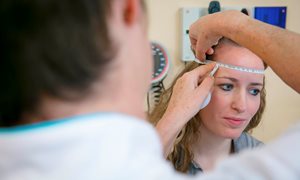
For a long time, healthcare professionals thought that only men could suffer from XLMTM, a serious muscle disease that is inherited via the X chromosome. Now research by the group of Nicol Voermans at the Radboud University Medical Center shows that women with this genetic defect also develop symptoms in half of the cases. This is important for early recognition and offers opportunities for treatment.
If you ask people what disorders differ between men and women, they will probably mention heart disease. And that's true, but sex differences are much more common. Hereditary muscle diseases are a good example. Nicol Voermans, neurologist at the Radboudumc, and her team have recently been investigating sex differences in so-called X-linked myotubular myopathy (XLMTM). This is a rare disease in which all skeletal muscles are weakened.
‘For a long time, doctors thought that only men could get this disease’, Voermans says. ‘The genetic cause lies on the X chromosome. A man has an X and a Y chromosome. A woman has two X's. Doctors thought that women would only be carriers of the disease, without symptoms, because the second, healthy X chromosome would compensate for the X chromosome with the genetic error. In men, this compensation is not possible because they have only one X chromosome.’
Carrier
In recent years, two international series of women with severe muscle weakness with this condition had been reported in literature. Voermans participated in one of these series. ‘When I held a presentation about this at a conference of the European Patients Association ZNM ZusammenStarkt!, a number of women came up to me and said that they also had mild to moderate symptoms. They asked how common it was. That was not known.’
Now Voermans, with two publications from her group, shows that about half of the women who carry this genetic defect develop symptoms due to XLMTM to some degree. This ranges from mild symptoms, such as difficulty climbing stairs, to severe muscle weakness, requiring a wheelchair and nocturnal ventilation. The other half of the women are only carriers of the genetic defect, without symptoms. Voermans first demonstrated this with questionnaires, followed by neurological tests for muscle strength and fitness.
Muscle symptoms
Women can pass on the disorder to their children. In men, the clinical picture is much more serious than in women. ‘In boys, it is the most serious muscle disease, often presenting itself just after birth with limpness and absence of crying. Many of these boys have to go straight to the ICU and are on a ventilator for a long time’, explains Voermans. ‘Some of these boys die very early; in their childhood or teenage years.’
The recognition that women can also develop symptoms due to XLMTM came thanks to whole exome sequencing, a technique that maps out all the genes in the DNA. ‘We started using that technique ten years ago at Radboudumc, thanks to the team of Erik-Jan Kamsteeg from our Department of Human Genetics,' Voermans says. ‘In the past, if a woman came with muscle complaints, they didn't test for XLMTM, but now it's a standard part of the genetic analysis. That's how we tracked down this cause in women with muscle weakness.’
Compensation
Apparently the healthy X chromosome in women does not fully compensate for the X chromosome with the genetic error. Voermans: ‘If you have two X chromosomes, one of them is turned off. In principle, your father's turns off about as often as your mother's. But it can be uneven. If the genetic error is located on your mother's chromosome and it stays on more often, then you might have that error in ninety percent of the cells in your body.’
Awareness that XLMTM can also cause muscle weakness in women leads to better recognition and treatment. For moderate complaints, this involves, for example, physical training, energy management and sleep advice. In case of severe complaints, rehabilitation may be necessary. In addition, women can use non-invasive ventilation at night. Thanks to this ventilation, survival in boys with XLMTM has now greatly improved.
More information
For more information about the Radboudumc Muscular Disease Center, click here (Dutch website).
This study was published in Neurology:
Spectrum of Clinical Features in X-Linked Myotubular Myopathy Carriers: An International Questionnaire Study. Stacha F.I. Reumers, Frederik Braun, Jennifer E. Spillane, Johann Bohm,
Maartje Pennings, Meyke Schouten, Anneke J. van der Kooi, A. Reghan Foley, Carsten G. Bonnemann, Erik-jan Kamsteeg, Corrie E. Erasmus, Ulrike Schara-Schmidt, Heinz Jungbluth, Nicol C. Voermans.
Neuromuscular features in XL-MTM carriers: a cross-sectional study in an unselected cohort of females. Daniëlle K. Franken, Karlijn Bouman, Stacha F.I. Reumers, Frederik Braun, Jennifer Spillane, Maartje Pennings, Saskia L.S. Houwen, Corrie E. Erasmus, Ulrike Schara-Schmidt, Erik-Jan Kamsteeg, Heinz Jungbluth, Nicol C. Voermans.
-
Want to know more about these subjects? Click on the buttons below for more news.
More information
Annemarie Eek

wetenschapsvoorlichter






